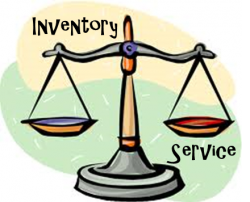Using Business Intelligence Software to Improve Inventory Levels
 A significant cost to many manufacturing and distribution organizations is the inventory they have to carry in order to support customers and sales. This inventory can easily represent 40-50% of a company’s capital investments. Right-sizing inventory gives companies the ability to increase their “return on inventory investment” without compromising service levels. After all, cutting corners that impact your customers, such as cutting inventory to cut costs which leads to shipment delays, causes more problems for the company in the long run.
A significant cost to many manufacturing and distribution organizations is the inventory they have to carry in order to support customers and sales. This inventory can easily represent 40-50% of a company’s capital investments. Right-sizing inventory gives companies the ability to increase their “return on inventory investment” without compromising service levels. After all, cutting corners that impact your customers, such as cutting inventory to cut costs which leads to shipment delays, causes more problems for the company in the long run.
But, fine tuning that “right size” of inventory where manufacturers can run lean without compromising service can be challenging if there is not complete visibility for the products on hand, or the right planning and optimization tools in place. Such tools are essential for segmenting inventories and building optimal plans that take demand variance, supply reliability and product obsolescence into consideration.
The key to improving inventory levels is business intelligence analytics. With a business intelligence system in place, manufacturers can better:
- Control inventory costs
- Improve service levels with the right product availability
- Better manage your inventory assets
- Prevent costly inventory build-up
- Keep out-of-stocks from happening
Business intelligence allows businesses to classify their products based on ABC analysis, also known as Selective Inventory Control. ABC analysis identifies which items have a significant impact on overall inventory cost, while also providing the means for identifying different categories of stock that will require different types of management and controls. This information can be used to set inventory targets based on classification schemes and to identify excessive or outdated inventories.
In addition, companies can leverage BI software to accurately plan and optimize their inventory based on historical sales, shipment, point-of-sale and other performance data such as trends in inventory turns. By understanding the breakdown of your inventory, managers can keep an eye on product inventory levels so that no particular product dips below a critical supply level. This helps ensure the company always has a minimum amount of inventory in stock so the supply chain never experiences a hiccup in delivery. Better assessing your reorder points also helps ensure your production line is never stalled because of missing components.
Business analytics software can measure:
- Available to promise (ATP)
- Days of supply
- Stock status
- Inventory valuation
- Projected shortages
- Excess inventory
With that information, suppliers can combine sales data, forecast data and replenishment data to ensure their stock levels are exactly where they need to be at all times. Since BI software can pull in data from so many sources, managers get a 360-degree view of their inventory that is accurate and up-to-date at all times. Suppliers and distributors can also use this data to identify which products have the slowest turnover, so they aren’t overstocked with products that don’t quickly produce revenue.
This real-time visibility, performance monitoring, and automatic alerts when unexpected variances or events take place give managers the insight they require to make better operational decisions – the kind of decisions that can ultimately drive down safety stock, reduce lost sales and minimize the costs and time related to inventory management.